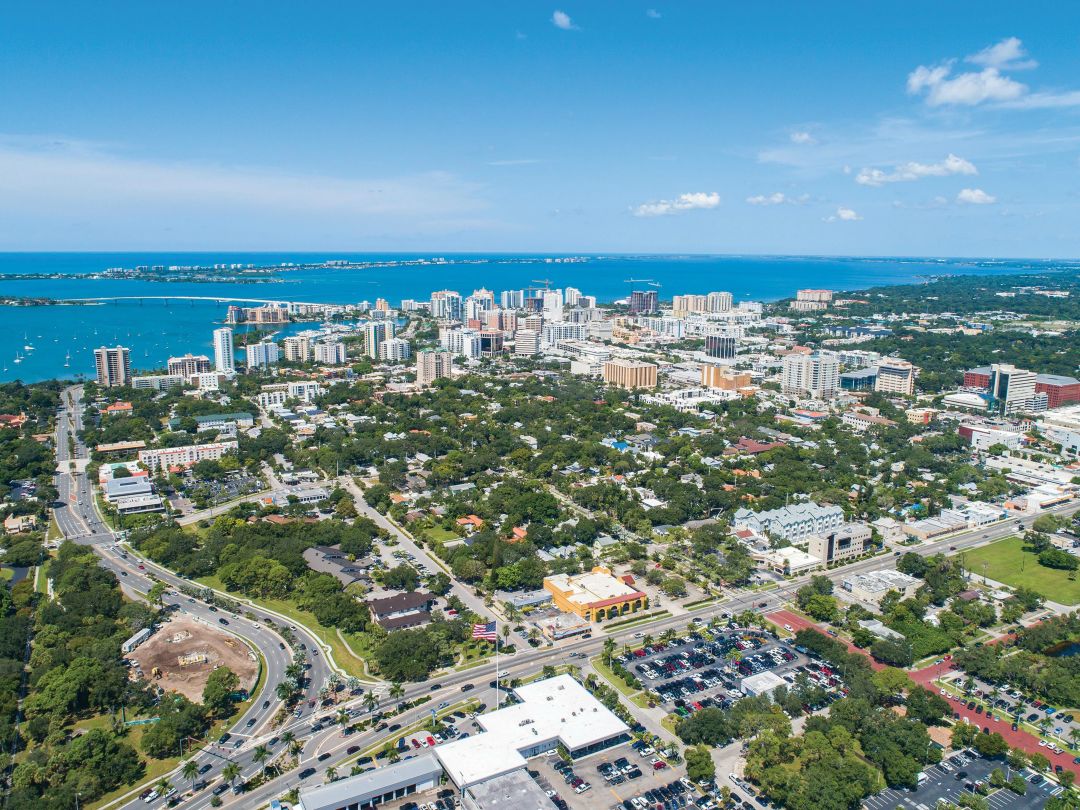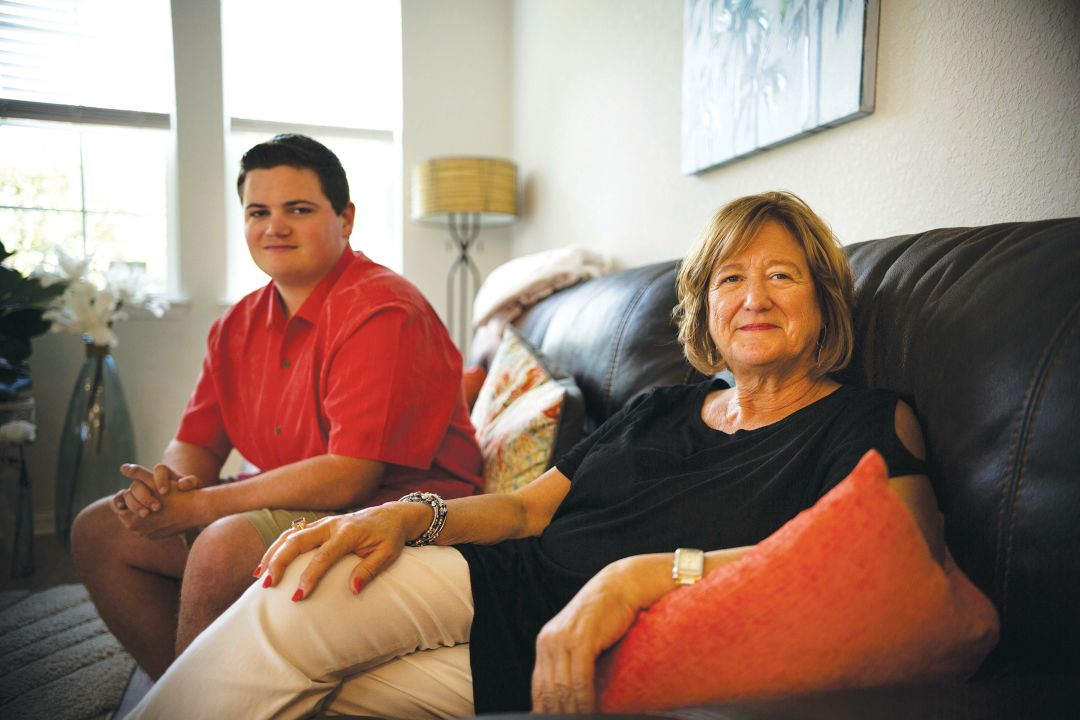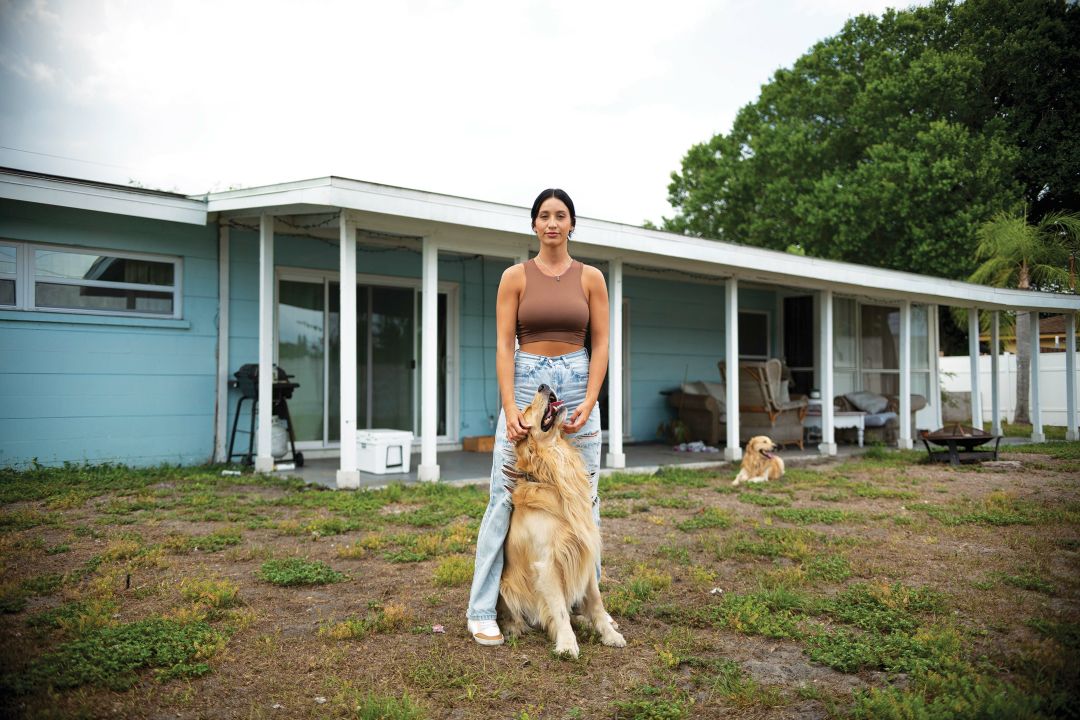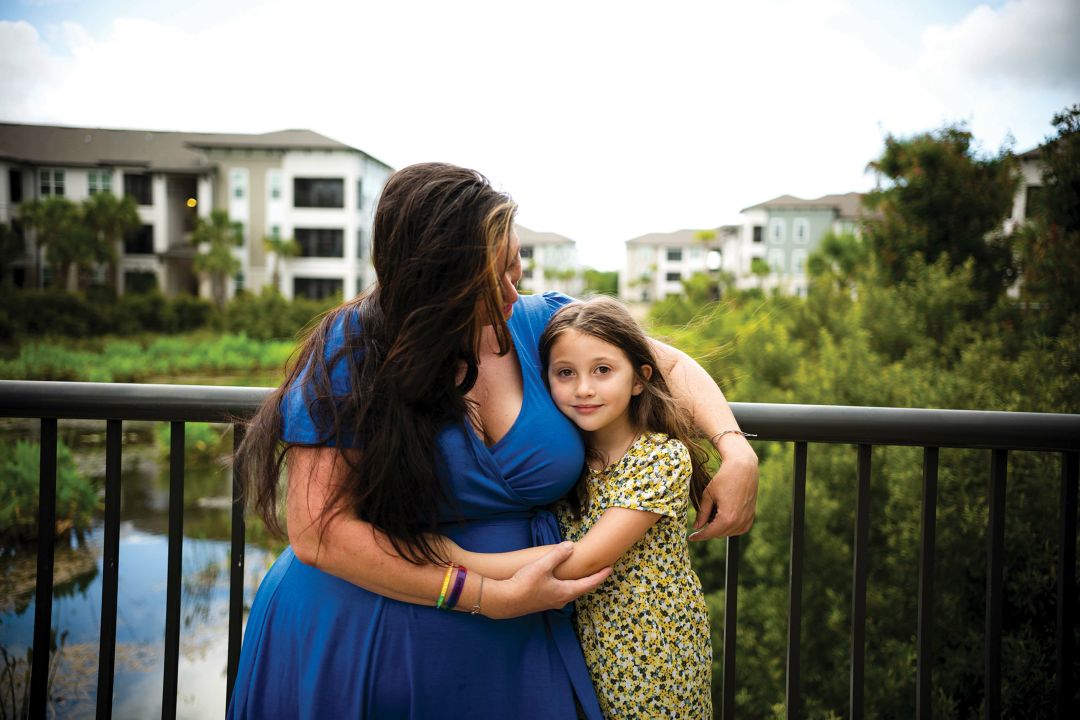
Inside Sarasota's Affordable Housing Crisis
In February 2021, following a divorce, Jules Scholles, 41, and her daughter Jade, 6, moved from North Port to Sarasota, where they found a two-bedroom, two-bathroom home to rent for $1,839 a month. “It felt like a lot,” says Scholles, who earns $70,000 a year as a mathematician who specializes in software implementation and digital marketing, “but it was still manageable and let me save for a home.”
Before the divorce, Scholles had also cared for two sibling foster kids. While Scholles and her daughter relocated, the children were separated and placed in different homes. In the meantime, Scholles hoped the children’s biological parents might be able to take them back, but if not, she planned to foster the children again and perhaps even adopt them. “I had them for a year and the bond we formed during that time was unbelievable,” says Scholles. “I feel like I’m really their mom in lieu. I’m just a person who deeply loves these children.”
Then, on Jan. 7 of this year, Scholles received word that her rent would be going up in March. She had a few options. She could pay $541 more each month if she signed a 15-month lease (a 29.4 percent increase), $1,302 more if she signed a 12-month lease (a 70.8 percent increase) or $1,765 more each month (nearly double) if she signed a month-to-month lease that covered her while she hunted for a better deal elsewhere.
“I’ve rented before, and it’s not out of the world to see your rent go up $100 a month, but when I got the notice I was blown away,” says Scholles, whose options were further limited by her daughter’s placement in school and restrictions on where she can move that are part of the custody agreement with her ex-husband.
The property management company gave her 17 days to make up her mind. “For two weeks, I was panicked,” says Scholles. “I’m running the numbers—the cost of movers and a deposit to get into another apartment. I looked around and there was just no place to go.” Scholles eventually signed the 15-month lease with the $541 rent increase. “That at least allowed me to keep my daughter in school until the end of next year,” she says.
Scholles had been saving up to purchase a home. Now, those savings are going toward rent, and the two children Scholles had hoped to foster and maybe adopt find themselves in limbo. Because they are brother and sister, Scholles would be required to rent or own a three-bedroom home or apartment to care for them. “When I looked, three-bedroom homes in the city started around $3,400 a month,” says Scholles. “Some places outside the county went for $2,900.” For a single mom, those prices are out of reach.
Scholles is still in touch with the two foster kids, now 14 and 9. “I feel terrible because there’s nothing I can do,” she says. “It’s sad. Not only could I not afford to move, but there’s also really just nowhere to go.”

In Sarasota, rent increases are exceeding wage increases.
While multimillion-dollar high-rise condos are stacking Sarasota’s skyline and rolling out amenities like concierges, valets, spas and dog grooming and sitting services, it’s a mystery where the people delivering all those services will live.
Just in the past year, Sarasota and Manatee counties have seen record-breaking hikes in rentals and home prices, and local salaries are no match. Based on the latest data from Apartment List, a national online marketplace for long-term residential rentals, overall median monthly rents in Sarasota County are now $1,945 and $1,877 in Manatee. One-bedroom abodes in both counties cost more than $1,500, and two-bedroom units are just under $2,000 a month.
Such numbers may not shock in places like Miami or San Francisco, but increases in what used to be considered affordable, mid-sized cities like Sarasota have been fast and furious. Over the past year, rental rates jumped by 40 percent in Sarasota County and 42 percent in Manatee. Those numbers are well above the state average of 28 percent and more than double the national average of 16.3 percent. The Sarasota-Bradenton-North Port metro area gained national attention when it showed a 47 percent uptick in rents since March 2020—the fastest growth among the 100 largest metro areas in the country.
Before getting into how that’s taking a toll on locals, squaring away some definitions is a must. According to the Florida Housing Coalition, when housing is deemed “affordable,” it means that no more than 30 percent of a family’s annual income goes toward housing costs. Imagine making $50,000 a year. If your home is affordable, no more than $15,000 a year should be going toward housing. That equates to $1,250 per month, a price point that has been foreign to local tenants for years. The last time Manatee County’s median rent hovered near that number was in mid-2018. In Sarasota County, it hasn’t been that low since January 2017.
As a result, half of all renting families in a five-county area that includes Sarasota and Manatee are now considered “rent-burdened,” meaning they are spending more than 30 percent of their monthly income on housing, according to the latest data collected by United Way Suncoast. Since last fall, local agencies have seen a 25 percent increase in the number of people seeking homelessness services, with almost 2,000 people more than usual requesting help, says Chris Johnson, the chief executive officer of the Suncoast Partnership to End Homelessness.
With limited legal protections, Florida tenants are left with few choices when rents increase overnight. There are no state or local caps on how much a property owner can increase rent, leaving landlords free to raise prices and charge as much as they like for a security deposit.
So why aren’t tenants turning to homeownership? Because housing is going through similar price inflations, and many working residents are being priced out. Based on April’s numbers, median prices for single-family homes in Sarasota County rose year-over-year by 27.1 percent to $482,803, while in Manatee they increased year-over-year by 27.2 percent to $515,000. Sarasota condo prices increased by 27.4 percent from last year to $395,000, and Manatee prices increased by 48.9 percent to $350,000.
And securing either is a race. The median time it took for properties to go under contract was just five days in April. First-time home buyers are being outbid by wealthy people making offers above the asking price, buying with cash and dropping appraisal addendums. Some homes are being sold after just a remote FaceTime walk-through, and condo developments are selling out before breaking ground.
The mania is being driven by high demand and low inventory. The pandemic, coupled with remote working options, led many people to rethink their priorities and quality of life. People searching for warm weather and more outdoor activities found Florida, where the wealth and high incomes they’re bringing with them can go a lot farther.
Rising interest rates may slow the grab for homes. The average rate for a 30-year fixed mortgage jumped to 5.72 percent this month, the highest level in 11 years. Likewise, the average cost of a 15-year fixed-rate mortgage has also increased, now, to 4.94 percent. But while those numbers may slow down house hunters who depend on financing, it could only push them into our bursting-at-the-seams rental market.
Many working people have long struggled to get by in stratified Sarasota, where high housing costs, an insufficient public transportation system and low-wage service industry and tourism jobs can make it difficult to get by. The recent spikes have put stress even on people like Scholles, who has two bachelor’s degrees—one in mathematics and another in nursing—and a successful white-collar career.
P.J. Brooks is the chief operating officer of CASL, which stands for Community Assisted & Supported Living. It’s a nonprofit focused on providing housing for tenants with mental health diagnoses. Brooks points out that it’s not just rents going up. Because of inflation and overseas conflict, people are also paying more for food and gas. “I wouldn’t say that people making $50,000 aren’t on the brink of homelessness,” says Brooks. “They’re on the precipice.”

Karen Hudgeons and her son Jake
Image: Joe Lipstein
It’s not just working people stressed by rising housing costs. Retirees are also feeling the burn. Sarasota often figures at the top of national “Best Places to Retire” lists. But for many retirees who live on a fixed income, those lists fail to factor in the reality of the soaring cost of living.
Karen Hudgeons, 64, moved from Philadelphia to Sarasota in 2020 after a car accident forced her into early retirement. Like many out-of-state transplants who headed south during the pandemic, Hudgeons “was so excited that I was going to be able to live here,” she says. And, at first, living in Sarasota was a dream. Due to the pandemic, “I got my first two months of rent-free,” says Hudgeons. She settled into what she calls "a beautiful complex."
But when her initial lease ended in September 2021, her rent went up by $200 a month, even though amenities like the gym at her complex had been shut down because of Covid-19 and social activities had been canceled. It’s not a huge hike, perhaps, but Hudgeons saw it as a red flag. Her rent started at $1,900 a month. Now it’s $2,100.
Hudgeons moved here with the intention of renting for a year while she looked for a home to buy. At first, it wasn’t hard to find potential properties. “Even in Lakewood Ranch, there were affordable communities,” says Hudgeons. “There was a wide variety of pricing.” But now, she says, “I can’t afford to buy.”
Hudgeons’ son, Jake Hudgeons, who works for the local county government, moved down to live with his mom and splits the rent with her. But because of Jake’s job, the two can’t move too far away from Sarasota, even if they find something more affordable outside the city. Their current lease is up again in September. “Come August, I’ll know what they’ll hike it up to,” says Hudgeons. “[But] I won’t be able to find the equivalent of where I live for the same price.”
Jake, 20, makes $51,000 a year but doesn’t picture himself moving out. “There’s no way I can live on my own in this area because of the expense,” he says. “I’m serving in law enforcement for the county, but I feel like the county doesn’t care about my housing expenses. I hope this ends soon, or at least some sort of subsidies go into affordable housing for people like me.”
Many young people like Jake, earning what was once considered a solid salary, have to reshuffle their priorities. Sarah Magda, 22, works as a server and a hairstylist and makes between $55,000 and $65,000 a year. She and a roommate live in a three-bedroom, two-bathroom home near the corner of Webber and Beneva, along with her two golden retrievers, Ranger and Rover.
When the roommates moved in together in September 2018, the house cost them $1,700 a month. But, this year, during the first week of March, the homeowner raised the rent to $2,400 overnight, despite making no improvements to the property.
Like Scholles, Magda and her roommate were given a month-to-month rental option that would have cost $125 more than the $2,400-a-month option for the annual lease, bringing their total rent to $2,525. Magda found that the cost of moving and finding another centrally located home that would welcome her dogs just wasn’t worth it. “A one-bedroom with a fenced-in yard in the city is at least $2,000 a month, based on what I’ve seen out there,” she says.
Despite earning above-average incomes (Sarasota County’s per capita income is $44,402, according to the United States Census Bureau), people like Jake and Magda are beholden to their roommates for housing. If Magda’s roommate decides to move out, Magda says she’d have to return to her hometown in Illinois.
“Their only asset is their wages,” says Jon Thaxton, a longtime affordable housing advocate and community leadership vice president for the Gulf Coast Community Foundation. “Any pay increases are wiped out by the cost of living now.”

Sarah Magda with her two dogs, Ranger and Rover
Image: Joe Lipstein
The housing crisis is also discouraging people from moving to Sarasota. Mary Dougherty is the executive director of the Gulf Coast Builders Exchange, a local nonprofit that represents many companies in the building industry. She says her members have stalled projects due to a shortage of workers. “Workers are taking offers in other places where living is more cost-effective,” she says. That’s despite salaries between $70,000 and $90,000 that they can earn here.
“My guys are so busy, and the labor shortage is the biggest issue,” says Dougherty. “The supply issue is there, but the labor shortage is exponential. It’s due to the cost of living.”
That’s a story that leaders from local businesses and nonprofits echoed at a Sarasota County Commission meeting last year. A representative from Sarasota Memorial Hospital, one of the area’s largest employers, said out-of-state candidates see that it costs $1,600 for an average one-bedroom apartment in Sarasota or $2,000 for a two-bedroom, and they turn down quality jobs. “Affordable housing is a major challenge for us,” the spokesperson said. “Some days, as many as six offers are turned down.”
Sarasota County Commissioner Alan Maio spoke of meeting with Sarasota County School Board officials who are dealing with the same challenge, despite the fact that the district offers one of the highest starting teacher salaries in the state.
County commissioners eventually voted to allot $25 million out of $84.2 million in federal American Rescue Plan Act funds the county was awarded toward building affordable housing. The funds will help build almost 700 new units that will go to people earning from as little as 30 percent of the area’s median income to 80 percent. But some of the units won’t be ready for occupancy until 2024 or even 2026—the deadline to spend the money.
An increase in the area’s median income level adds another curveball. The median income figure is used by the U.S. Department of Housing and Urban Development to determine people’s eligibility for various housing programs, and many rent limits are based on how a family’s income compares to the median. This year, the median income for a family of four in the North Port-Sarasota-Bradenton region increased from $77,000 to $90,400—more than twice the national increase. That means more residents are eligible for affordable housing assistance, but also that people already living in affordable units may see their rent go up.
Local officials are taking notice. Last year, Sarasota city and county commissioners voted to allow homeowners to build what are called additional dwelling units (or ADUs) on their properties, with the goal of increasing the area’s affordable housing stock. Under the new provisions, homeowners can build an ADU on a property zoned for a single-family home. Conditions include a cap on rents and limits on how big the units can be.
The move represented a step in the right direction. But with the soaring cost of building materials (and that’s if they’re available), plus a labor shortage in a high-demand market, most estimates put the cost of building an ADU at between $250 and $350 a square foot, a price that just isn’t realistic for most residents.
The idea of increasing density in certain parts of downtown Sarasota has also been thrown on the table as a possible solution to the crisis. But longtime residents fear it’s merely a gateway for developers and investors to profit more from buildings that can go higher in the sky. Proponents of the idea say it’s an effective way to increase housing and lay the groundwork for more affordable units.
After hearing from more than 50 public speakers on the matter in May, the Sarasota City Commission voted to give developers density bonuses when affordable housing units are made part of a project. Projects could also be approved by city staff, rather than have to go through a lengthy public hearing process. As it stands, the maximum residential density allowed in Sarasota’s downtown core is 50 units per acre—just one-quarter of the 200 units per acre developers are permitted in downtown Bradenton, if they earn density bonuses. As for height, Sarasota currently allows for 10-story buildings in the downtown core, and the city has shelved a proposal to allow developers to build taller than that.
The city’s plans are currently being reviewed by the state, with final approval expected later this year. Even when implemented, the changes only offer incentives to build affordable housing units. Developers will need to voluntarily opt in to the system and then actually build the units. Even if it succeeds, new housing won’t be available for years.
It’s not the first time density bonuses have been applied for projects that contain affordable housing. In the Rosemary District, developers can build up to 100 units per acre instead of just 40 if they include affordable units. In the three years since that provision was adopted, just one developer has taken advantage of the bonus and plans to include 47 affordable units in a 157-unit apartment project slated for the corner of 10th Street and Cocoanut Avenue.
Aside from that, there’s not much open space left. “Most of the land has already been developed,” says William Russell, the president and chief executive officer of the Sarasota Housing Authority, an agency that provides public housing and works with all levels of government to establish low- and mixed-income residential units.
Thaxton is skeptical that density bonuses will make much of an impact. “For 40 years, I’ve seen these types of density bonuses never pay off,” he says. “We stopped building housing for the people who assure the quality of life we all enjoyed 30 years ago. The market and density bonuses are just not producing units.”

Jules Scholles and her daughter Jade
Image: Joe Lipstein
Other cities have gone farther. Some have instituted what are known as vacancy taxes—fees charged to property owners who leave homes vacant. Such taxes incentivize owners of unused units to put them on the market, either for rent or for sale, which adds to the overall housing supply and eventually helps bring down prices.
If property owners choose to leave units vacant and pay the tax, that revenue goes to the city and can be invested in affordable housing initiatives. In a city where new patient forms at the doctor’s office often ask for a second address, and where part-time residents commonly use “winter” as a verb, vacancy taxes could help ease the affordable housing crisis.
Meanwhile, cities like Minneapolis, Minnesota; Charlotte, North Carolina; and Portland, Oregon have explored different ways of ending single-family-only zoning, allowing duplexes and even triplexes or fourplexes to be built on single-family lots as a way to increase housing stock.
A model from Nashville, Tennessee, a city facing an affordable housing crisis of its own, may be gaining traction locally. Called the Low Barrier Housing Collective, the Nashville model is a partnership between social services agencies and landlords who receive incentives in exchange for lowering rental barriers. The most crucial piece of the model relies on landlords willing to be part of the solution, but that may be a tough sell for property owners who lost rental revenue because of the federal government’s pandemic-era eviction moratorium.
“We’re not asking them to be a caseworker,” says Lauren Bowen, the housing project manager for the Suncoast Partnership to End Homelessness. “We know the moratorium hit some landlords hard, and the financial piece is pivotal for them, too. But I believe they’ll be interested once we’re able to offer incentives.”
Those incentives include things like $1,000 on top of a deposit in case of property damage, up to two months of rent if tenants break a lease and case management services provided by nonprofits that help renters with a range of services from employment aid to health care access.
“Having the agencies and nonprofits all together in a room, sharing barriers they come up against and coming at this crisis together, and seeing how Nashville was able to streamline this model is pivotal,” says Bowen. “It just gives me a lot of hope.”
In the meantime, many in Sarasota are struggling.
“I would’ve never thought at $51,000 a year, I would worry about my basic needs,” says Jake Hudgeons. “I’ve cut back on haircuts. I’m being more frugal. I thought law enforcement would be a good, dependable career, but the gouging is pushing me out.”
Jake’s mother, Karen Hudgeons, is similarly uncertain about what’s to come. “I see myself going back to work due to this situation,” she says. “But I’m also worried about the low salaries, so I wonder what the future holds.”